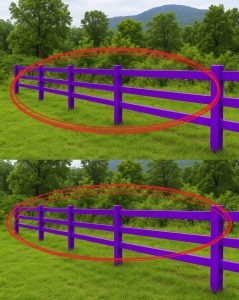Have you ever been walking through a quiet neighborhood or hiking along a country trail and noticed a fence painted bright purple? Not the typical brown, white, or natural wood — but a bold shade that looks almost out of place, as if someone dipped their fence in grape Kool-Aid. You might wonder: Why purple? Is it just a strange design choice?
Actually, no. That purple paint isn’t random — it’s a warning. A purple-painted fence, post, or tree means one clear thing: “No trespassing.”
In several U.S. states, purple paint has become a legally recognized way for landowners to mark their property boundaries without putting up dozens of signs. Instead of hanging metal “Keep Out” notices that can rust, fade, or blow away, a few well-placed purple stripes do the same job — and often, they do it better.
The Rules of the Purple Paint Code
If you’re thinking of painting your own fence purple to protect private land, there’s more to it than just brushing on some color. States that recognize “purple paint laws” have specific rules about how and where it should be applied so that the message is unmistakable.
1. The shape and direction matter.
The paint marks must be vertical, not random brushstrokes or horizontal streaks. These vertical stripes tell passersby that the paint was placed intentionally as a boundary marker — not by someone who just got creative with leftover paint.
2. Size is important.
Each stripe must generally be at least one inch wide and about eight inches long — large enough to be noticed from a distance. Tiny smudges or faint streaks won’t cut it; the purpose is visibility and clarity.
3. Height and spacing count, too.
The purple marks must usually be painted 3 to 5 feet off the ground. If they’re too low, tall grass or shrubs could cover them; too high, and most people won’t see them. To mark property effectively, paint a stripe every 100 feet or so along fence lines, tree trunks, or posts.
These details are more than just recommendations — in many states, they’re written into law. Following the guidelines ensures that the markings are legally valid and recognizable to anyone approaching the property.
Where It’s Legally Recognized

Not every state uses the purple paint rule, so before you grab a brush, check your local regulations. States such as Texas, North Carolina, Illinois, Missouri, Kansas, and Pennsylvania have official purple paint laws, while others are considering adopting them.
In these areas, a purple stripe carries the same legal weight as a posted “No Trespassing” sign. Entering land marked with these paint codes without permission can result in trespassing charges.
In states where the law isn’t recognized, purple paint may serve more as a courtesy or informal warning rather than a legally binding one. That’s why checking state and county guidelines is essential before assuming your fence marks will hold up in court.
Why Purple?

It might seem like an odd color to use, but purple wasn’t chosen by accident. In most outdoor settings, purple doesn’t naturally appear, especially on wood, stone, or trees — making it instantly eye-catching.
Unlike red or orange, which can fade quickly in the sun or blend into autumn scenery, purple stands out all year long. It’s visible in bright light and in dim evening conditions. Plus, it’s a color that few people mistake for anything else, making the message crystal clear: This land is private. Please stay out.
Beyond visibility, purple paint is practical. Signs can fall, get stolen, or deteriorate over time. Paint, on the other hand, is inexpensive, durable, and easy to reapply when needed. For farmers, ranchers, or rural landowners with miles of fencing, this system is simple, efficient, and legally sound.
Not Just for Fences

Purple paint markings aren’t limited to fences. In many rural areas, trees, rocks, and posts are also painted to mark property boundaries. Hikers, hunters, and campers are trained to recognize the symbol as a “no entry” warning.
If you’re exploring the countryside and see a tree trunk or wooden post marked with a purple line, it’s best to turn around. It’s not a trail marker or artistic statement — it’s a boundary notice with real significance.
A Simple Color with a Serious Message
While the idea of using purple paint to signal “keep out” might sound quirky at first, it’s an ingenious solution. It conveys an unmistakable message without the need for words or signs.
The system is low-cost, low-maintenance, and highly effective — a visual cue that speaks the same language to everyone, regardless of literacy or language barriers.
So, the next time you’re out walking, driving through farmland, or exploring wooded trails and you spot a purple fence or a streak of purple paint on a tree, remember: it’s not there for decoration. It’s a silent sign of ownership and protection.
The Bottom Line
Purple paint isn’t just a quirky trend — it’s a practical, legal, and recognizable boundary marker. It protects property owners, reduces the need for constant sign replacement, and helps ensure that visitors or hikers know when they’re crossing into private land.
So next time you see that flash of purple along a fence line, take note. It’s not just paint — it’s a message. Respect it, turn back, and appreciate that even a single streak of color can say so much.
Sources:
